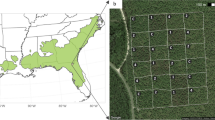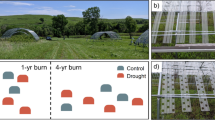Abstract
In southwestern American deserts, fire has been historically uncommon because of insufficient continuity of fuel for spreading. However, deserts have been invaded by exotic species that now connect the empty space between shrubs to carry fire. We hypothesized that fire would change the spatial distribution of surviving Larrea tridentata shrubs. We established two study plots, one each in a burned and unburned area, and recorded location and living status of all shrubs. We performed univariate and bivariate point pattern analyses to characterize the impact of fire on the overall distribution of shrubs. Additionally, we used a simple wildfire model to determine how close we could come to reconstructing the observed spatial pattern of living and dead shrubs. We found a hyper-dispersed pattern of shrubs at finer scales and a random pattern at broader scales for both the unburned plot and for the living and dead shrubs combined in the burned plot, the latter providing an approximation of the pre-burn distribution of shrubs. After fire, living shrubs showed a clustered pattern at scales >2.5 m, whereas dead shrubs were randomly distributed, indicating that fire caused a change in the spatial pattern of the surviving shrubs. The fire model was able to partially reconstruct the spatial pattern of Larrea, but created a more clustered distribution for both living and dead shrubs. Our study reinforces the key role of fire in altering landscapes that had not been habituated to fire, and suggests the existence of potential cascading effects across the entire plant community.






Similar content being viewed by others
References
Abella SR (2009) Post-fire plant recovery in the Mojave and Sonoran deserts of western North America. J Arid Environ 73:699–707. doi:10.1016/j.jaridenv.2009.03.003
Abella SR (2010) Disturbance and plant succession in the Mojave and Sonoran deserts of the American Southwest. Int J Environ Res Public Health 7:1248–1284. doi:10.3390/ijerph7041248
Adou JK, Billaud Y, Brou DA, Clerc JP, Consalvi JL, Fuentes A, Kaiss A, Nmira F, Porterie B, Zekri L, Zekri N (2010) Simulating wildfire patterns using a small-world network model. Ecol Model 221:1463–1471. doi:10.1016/j.ecolmodel.2010.02.015
Allen EB, Steers RJ, Dickens SJ (2011) Impacts of fire and invasive species on desert soil ecology. Rangel Ecol Manag 64:450–462. doi:10.2111/rem-d-09-00159.1
Baddeley A, Turner R (2005) spatstat: An R package for analyzing spatial point patterns. J Stat Softw 12:1–42
Baddeley A, Diggle PJ, Hardegen A, Lawrence T, Milne RK, Nair G (2014) On tests of spatial pattern based on simulation envelopes. Ecol Monogr 84:477–489
Bowers JE, Turner RM, Burgess TL (2004) Temporal and spatial patterns in emergence and early survival of perennial plants in the Sonoran Desert. Plant Ecol 172:107–119. doi:10.1023/B:VEGE.0000026026.34760.1b
Bowman DMJS, Balch JK, Artaxo P, Bond WJ, Carlson JM, Cochrane MA, D’Antonio CM, DeFries RS, Doyle JC, Harrison SP, Johnston FH, Keeley JE, Krawchuk MA, Kull CA, Marston JB, Moritz MA, Prentice IC, Roos CI, Scott AC, Swetnam TW, Van der Werf GR, Pyne SJ (2009) Fire in the Earth system. Science 324:481–484. doi:10.1126/science.1163886
Brooks ML, Lusk M (2008) Fire management and invasive plants: a handbook for land managers. United States Fish and Wildlife Service, Arlington
Brooks ML, Matchett JR (2006) Spatial and temporal patterns of wildfires in the Mojave Desert, 1980–2004. J Arid Environ 67:148–164. doi:10.1016/j.jaridenv.2006.09.027
Brooks ML, D’Antonio CM, Richardson DM, Grace JB, Keeley JE, DiTomaso JM, Hobbs RJ, Pellant M, Pyke D (2004) Effects of invasive alien plants on fire regimes. Bioscience 54:677–688. doi:10.1641/0006-3568
Brown DE, Minnich RA (1986) Fire and changes in Creosote bush scrub of the western Sonoran desert, California. Am Midl Nat 116:411–422
Burgess TL, Bowers JE, Turner RM (1991) Exotic plants at the desert laboratory, Tucson, Arizona. Madroño 38:96–114
Burquez-Montijo A, Miller ME, Martinez-Yrizar A (2002) Mexican grasslands, thornscrub, and the transformation of the Sonoran Desert by invasive exotic buffelgrass (Pennisetum ciliare). In: Tellman B (ed) Invasive exotic species in the Sonoran region. University of Arizona Press and The Arizona-Sonora Desert Museum, Tucson, pp 126–146
Cary GJ (2002) Importance of a changing climate for fire regimes in Australia. Flammable Australia: the fire regimes and biodiversity of a continent, chap 2. Cambridge University Press, Cambridge, pp 26–46
D’Antonio CM, Vitousek PM (1992) Biological invasions by exotic grasses, the grass/fire cycle, and global change. Annu Rev Ecol Syst 23:63–87
Diggle PJ (2003) Statistical analysis of spatial point patterns, 2nd edn. Arnold, London
Esque TC, Webb RH, Wallace CSA, van Riper CIII, McCreedy C, Smythe L (2013) Desert fires fueled by native annual forbs: effects of fire on communities of plants and birds in the lower Sonoran Desert of Arizona. Southwest Nat 58:223–233. doi:10.1894/0038-4909-58.2.223
Fonteyn PJ, Mahall BE (1978) Competition among desert perennials. Nature 275:544–545. doi:10.1038/275544a0
Fonteyn PJ, Mahall BE (1981) An experimental-analysis of structure in a desert plant community. J Ecol 69:883–896. doi:10.2307/2259643
Goreaud F, Pelissier R (2003) Avoiding misinterpretation of biotic interactions with the intertype K-12-function: population independence vs. random labelling hypotheses. J Veg Sci 14:681–692. doi:10.1111/j.1654-1103.2003.tb02200.x
Grissino-Mayer HD, Swetnam TW (2000) Century-scale climate forcing of fire regimes in the American Southwest. Holocene 10:213–220. doi:10.1191/095968300668451235
Kenkel NC (1988) Pattern of self-thinning in Jack pine: testing the random mortality hypothesis. Ecology 69:1017–1024. doi:10.2307/1941257
Loosmore NB, Ford ED (2006) Statistical inference using the G or K point pattern spatial statistics. Ecology 87:1925–1931
MacMahon JA (1999) Disturbance in deserts. In: Walker LL (ed) Ecosystems of disturbed ground, vol 16, 1st edn. Elsevier, Amsterdan, pp 307-330
Mahall BE, Callaway RM (1992) Root communication mechanisms and intra-community distributions of 2 Mojave Desert shrubs. Ecology 73:2145–2151. doi:10.2307/1941462
McDonald CJ, McPherson GR (2013) Creating hotter fires in the Sonoran Desert: buffelgrass produces copious fuels and high fire temperatures. Fire Ecol 9:26–39. doi:10.4996/fireecology.0902026
McDonough WT (1963) Interspecific associations among desert plants. Am Midland Nat 70:291–299. doi:10.2307/2423057
McLaughlin SP, Bowers JE (1982) Effects of wildfire on a Sonoran desert plant community. Ecology 63:246–248
Miriti MN (2007) Twenty years of changes in spatial association and community structure among desert perennials. Ecology 88:1177–1190. doi:10.1890/06-1006
Mudrak EL, Schafer JL, Fuentes-Ramirez A, Holzapfel C, Moloney KA (2014) Predictive modeling of spatial patterns of soil nutrients related to fertility islands. Landsc Ecol 29:491–505. doi:10.1007/s10980-013-9979-5
O’Leary JF, Minnich RA (1981) Postfire recovery of creosote bush scrub vegetation in the western Colorado Desert. Madrono 28:61–66
Raventós J, Wiegand T, De Luis M (2010) Evidence for the spatial segregation hypothesis: a test with nine-year survivorship data in a Mediterranean shrubland. Ecology 91:2110–2120. doi:10.1890/09-0385.1
Rayburn AP, Schiffers K, Schupp EW (2011) Use of precise spatial data for describing spatial patterns and plant interactions in a diverse Great Basin shrub community. Plant Ecol 212:585–594. doi:10.1007/s11258-010-9848-0
Ripley BD (1981) Spatial statistics. Wiley, New York
Rutman S, Dickson L (2002) Management of buffelgrass on Organ Pipe Cactus National Monument, Arizona. In: Tellman B (ed) Invasive exotic species in the Sonoran region. University of Arizona Press, Tucson, pp 311–318
Sagarin R, Pauchard A (2012) Observation and ecology. Island Press, Washington, DC
Schafer JL, Mudrak EL, Haines CE, Parag HA, Moloney KA, Holzapfel C (2012) The association of native and non-native annual plants with Larrea tridentata (creosote bush) in the Mojave and Sonoran deserts. J Arid Environ 87:129–135. doi:10.1016/j.jaridenv.2012.07.013
Schenk HJ, Holzapfel C, Hamilton JG, Mahall BE (2003) Spatial ecology of a small desert shrub on adjacent geological substrates. J Ecol 91:383–395. doi:10.1046/j.1365-2745.2003.00782.x
Schlesinger WH, Raikes JA, Hartley AE, Cross AF (1996) On the spatial pattern of soil nutrients in desert ecosystems. Ecology 77:1270. doi:10.2307/2265595
Stoyan D, Stoyan H (1996) Estimating pair correlation functions of planar cluster processes. Biom J 38:259–271. doi:10.1002/bimj.4710380302
Sugihara NG, van Wagtendonk JW, Fites-Kaufman J (2006) Fire as an ecological process. In: Sugihara NG, Wagtendonk JWV, FitesKaufman J, Shaffer KE, Thode AE (eds) Fire in California’s ecosystems. University of California Press, Berkeley, pp 58–74
Sunderman SO, Weisberg PJ (2012) Predictive modelling of burn probability and burn severity in a desert spring ecosystem. Int J Wildland Fire 21:1014–1024. doi:10.1071/wf11172
Tirado R, Pugnaire FI (2003) Shrub spatial aggregation and consequences for reproductive success. Oecologia 136:296–301. doi:10.1007/s00442-003-1264-x
Whelan RJ (1995) The ecology of fire. Cambridge University Press, Cambridge
Wiegand T, Moloney KA (2004) Rings, circles, and null-models for point pattern analysis in ecology. Oikos 104:209–229. doi:10.1111/j.0030-1299.2004.12497.x
Wiegand T, Moloney KA (2014) Handbook of spatial point pattern analysis in ecology. Chapman and Hall/CRC, Boca Raton
Wiegand T, He F, Hubbell SP (2013) A systematic comparison of summary characteristics for quantifying point patterns in ecology. Ecography 36:92–103. doi:10.1111/j.1600-0587.2012.07361.x
Wilensky U (1999) NetLogo. Center for Connected Learning and Computer-Based Modeling, Northwestern University, Evanston. http://ccl.northwestern.edu/netlogo/
Yeaton RI, Travis J, Gilinsky E (1977) Competition and spacing in plant communities: Arizona upland association. J Ecol 65:587–595. doi:10.2307/2259503
Acknowledgments
Funding was provided by the Department of Defense’s Strategic Environmental Research and Development Program (SERDP), USA: Project RC-1721, Holzapfel & Moloney. We thank Ruth Sparks, David Housman, Richard Whittle and Teresa Walker for logistical help and Carolyn Haines, Jennifer Schafer, Marjolein Schat, and Hadas Parag for their help in the field. We also thank two anonymous reviewers for comments and improvements on this manuscript. A.F.R. is supported by Becas Chile 2010, CONICYT, Ministry of Education, Chile. This research complies with the current laws of the United States of America in which the study was performed.
Author information
Authors and Affiliations
Corresponding author
Additional information
Communicated by Truman Young.
Rights and permissions
About this article
Cite this article
Fuentes-Ramirez, A., Mudrak, E.L., Caragea, P.C. et al. Assessing the impact of fire on the spatial distribution of Larrea tridentata in the Sonoran Desert, USA. Oecologia 178, 473–484 (2015). https://doi.org/10.1007/s00442-014-3214-1
Received:
Accepted:
Published:
Issue Date:
DOI: https://doi.org/10.1007/s00442-014-3214-1




